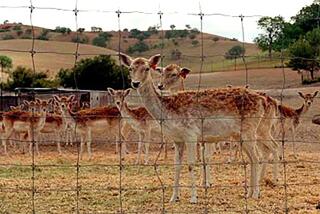State Report Criticizes Hearst Ranch Deal
As state officials near a key decision on the $95-million deal to preserve Hearst Ranch, the terms of the transaction are coming under increasing criticism that the deal is too generous to the Hearst Corp.
The latest critique, from the legislative analyst’s office, a nonpartisan fiscal watchdog, contends that the deal may be based on a faulty appraisal and lacks specific, enforceable provisions to protect wildlife and rare plants. It recommends that the state withhold endorsement until a closer analysis can be made.
The report and other criticisms have infuriated the deal’s supporters, who fear it may disrupt a historic opportunity to preserve the majestic 18-mile stretch of coastal tablelands and unblemished hillsides that surround Hearst Castle in San Simeon, south of Big Sur.
Yet California Resources Secretary Mike Chrisman said the deal will proceed on schedule for its first round of approvals at Thursday’s meeting of the Wildlife Conservation Board.
“There may very well be things that change through this,” he said of the complicated conservation easement for the 128-square-mile ranch. “We have an open mind with this.”
The legislative analyst’s office scrutinized the deal as part of its job to examine large expenditures of taxpayer-supported bond funds. Its report was especially critical of the fact that state wildlife experts have not been allowed to review an inventory of rare plants and endangered wildlife and would have virtually no oversight role to ensure their long-term protection.
It also complained that many key documents have been kept confidential, including the details of an appraisal that valued the package of land and development rights that the Hearst Corp. is relinquishing at $230 million.
The analyst’s report noted that the Department of General Services valued the deal at “at least $110 million.”
“While we are aware than an independent appraiser ... arrived at a fair market value appraisal of $230 million, the [Wildlife Conservation Board] has indicated that this appraisal does not meet DGS’ standards,” according to the report, which was prepared for the Joint Legislative Budget Committee.
“The legislative analyst has raised serious questions: Is it a good deal for taxpayers? Are we getting our money’s worth?” said Sen. Wes Chesbro (D-Arcata), the committee chairman.
Chesbro sent a letter asking Chrisman to respond to criticisms and recommended changes, which Chrisman said he would do.
But Chrisman took issue with one part of the report, saying that the Department of General Services’ real estate experts have not determined that the appraisal fails to meet state standards. “No decision has been made,” he said. “They’re still looking at it.”
Shirley Bianchi, a San Luis Obispo County supervisor who lives near Hearst Ranch, worries that the report and criticism from the California Coastal Commission and the Sierra Club and other groups will cause Hearst Corp. directors to abandon the deal and resurrect plans to develop the historic ranch.
“They could go back to their own proposal to build 640 hotel and motel rooms and a golf course,” Bianchi said. “And they could get it if the Coastal Commission [membership] turns over and becomes a pro-development commission, which has happened in the past.”
The first state official to question the deal was Peter Douglas, executive director of the Coastal Commission, who characterized the deal as a “bait-and-switch scam” that promised public benefits in exchange for public dollars but failed to make good on its promise.
In particular, Douglas faulted terms of the agreement that would severely restrict public access to about five miles of coast, which the public has long used without restriction.
“I’m not trying to kill this deal, I’m trying to improve it,” he said.
The commission staff late Thursday released a draft of the 48-page analysis of the deal, recommending that “subdivision of the ranch for residential purposes should be prohibited.” It also recommends that Hearst sell all 18 miles of shoreline to the state, not just the 13 miles as currently proposed. In addition, it recommends that an extension of the California Coastal Trail run along the shoreline and be linked to a new public trail on the east side of the ranch.
Under the proposed deal, the Hearst Corp. has agreed to sell more than 1,500 acres of land west of California 1 to the state and give up the rights to develop about 400 homes on the ranch’s nearly 82,000 acres. In return, it would receive a total of $95 million, including $23 million in federal transportation dollars to preserve scenic highway views and $57 million from state conservation bonds.
The Hearst Corp., which owns the San Francisco Chronicle, magazines, television stations and is a part-owner of ESPN, also would receive $15 million in state tax credits.
In addition, the corporation has indicated that it plans to seek a federal tax write-off for a charitable contribution -- amounting to the difference between the $95 million and the full appraised value of $230 million.
The Hearst Corp. would retain the right to build a 100-room hotel in Old San Simeon Village at the base of San Simeon Point. The hotel would serve visitors to Hearst Castle, which was donated to the state in 1957 and is run by the state Department of Parks and Recreation.
The Hearst family also would be able to develop 27 homes tucked into valleys deep in the ranch on five-acre lots with 25-acre buffer zones. Any of those could be sold to outsiders, and either the Hearst Corp. or buyers would be permitted to build wineries on those parcels, provided that most of the grapes were grown on the ranch.
Under the agreement, 300 acres of vineyards would be allowed on the ranch and another 300 acres of orchards. An additional 2,400 acres of irrigated pasture or row crops, such as snow peas, would be allowed. The remainder of the ranch would remain as open grazing land, which is the predominant use now. An additional 15 homes could be built for ranch employees.
Some state biologists, conservation groups and the legislative analyst’s office pointed out that the conservation easement does not guarantee protection of the richest areas of rare plants or endangered species, although it does require buildings to be 100 feet from streambeds.
Hearst Ranch, according to state documents, has 1,000 plant and wildlife species, including elk, mountain lions, black bears, bobcats, federally protected red-legged frogs, tidewater gobies and steelhead trout. It contains 17 plants listed by the California Native Plant Society, including some plants that exist nowhere else. The Hearst Corp. has conducted a survey of the wildlife and other natural resources. But, up to now, it has not shared it with state Department of Fish and Game biologists, who usually scrutinize such documents.
The Hearst Corp. has insisted that state officials have a minimal oversight role.
A yearly assessment of wildlife would be done by the nonprofit California Rangeland Trust, which was established to conserve working cattle ranches with similar conservation easements.
The state would have a seat on a committee that would audit the monitoring every five years. The monitoring reports and audits would be kept confidential.
The legislative analyst’s office concluded that such monitoring would be inadequate. It also criticized a provision of the deal that states it would prohibit “impairment” of natural resources without providing “sufficient guidance as to what would constitute an ‘impairment.’ ”
The Hearst Corp., which declined to comment on the report, has repeatedly said that the resident rare plants and animals would not be on the ranch if the family had not been responsible caretakers.
“The Hearsts have been good stewards of that land for 140 years. I don’t know why they would turn around and be bad stewards now,” said Jack Varian, a Monterey County rancher who supports the deal. He said any conservation plan for private land must contain a level of trust.
But the analyst’s report cautions that “while the current property owners are considered good stewards of the natural resources on the property, future ownership may not share the same stewardship values.”
More to Read
Sign up for Essential California
The most important California stories and recommendations in your inbox every morning.
You may occasionally receive promotional content from the Los Angeles Times.










